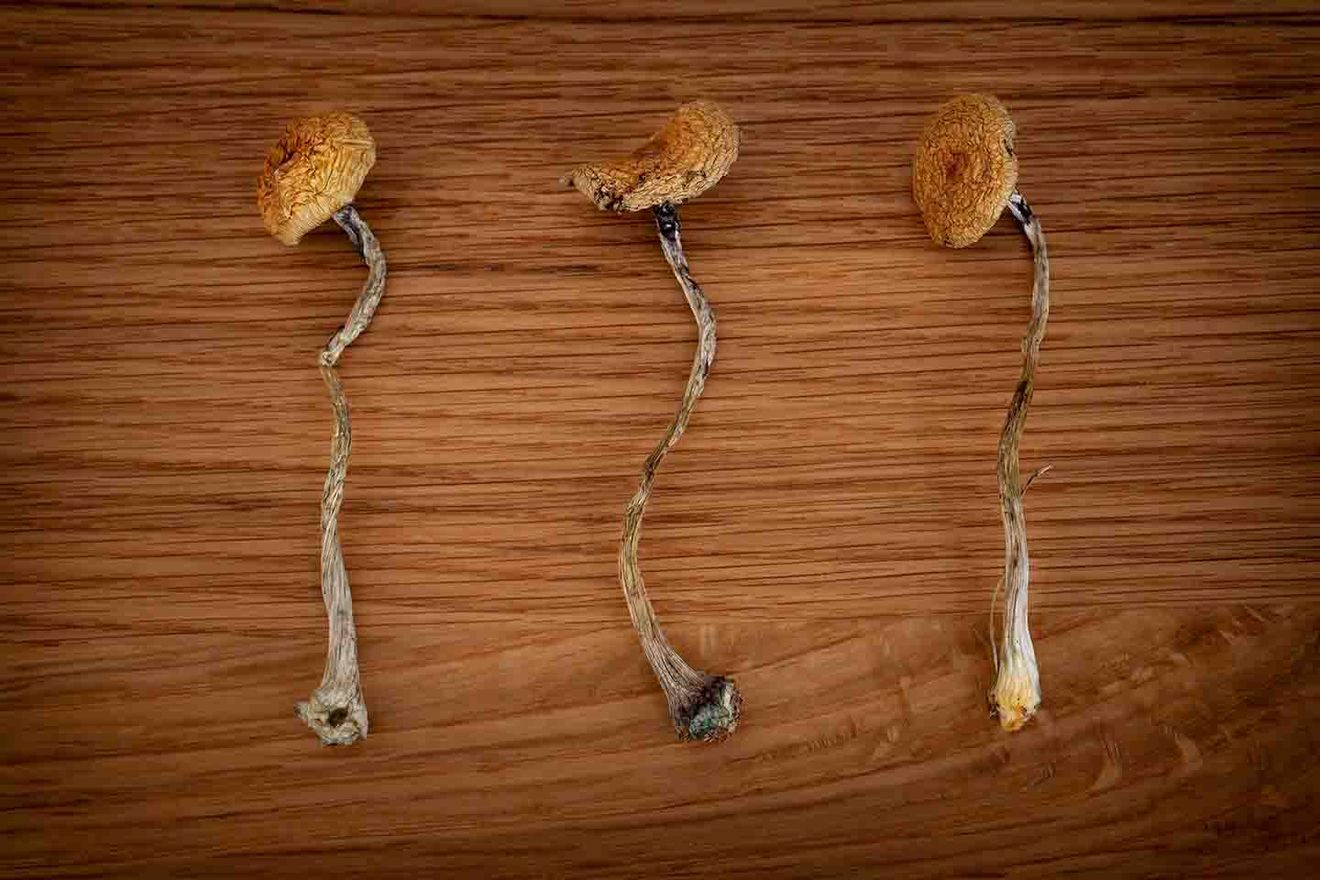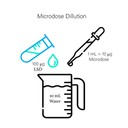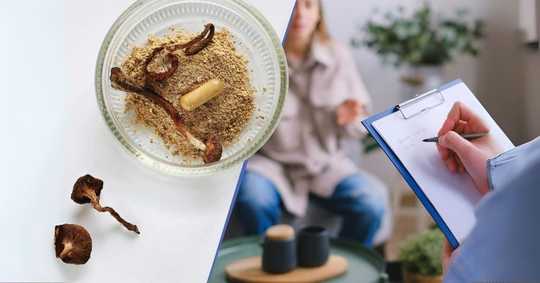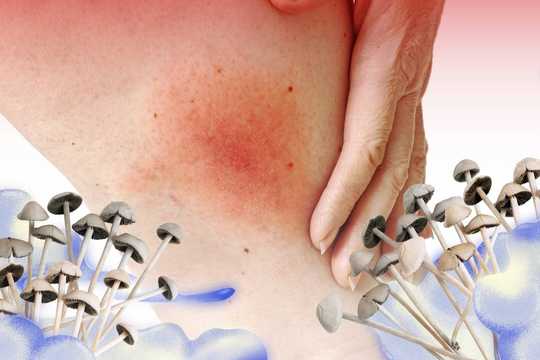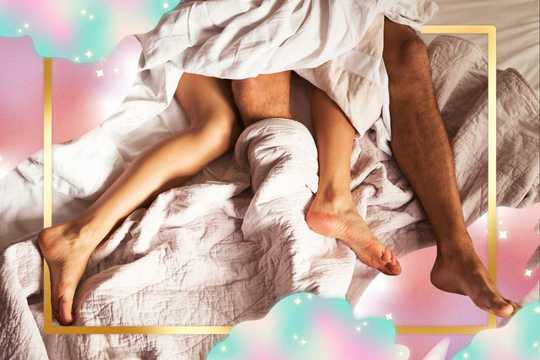From migraine stopper to creativity boosters, microdosing is hailed as an all-inclusive approach to your physical and psychological issues. At least that is what the latest headlines are touting. But are the anecdotal reports real? Or is something else responsible for the purported benefits? Join Dr. Allison Feduccia, PhD as we separate microdose facts from fiction.
What is Microdosing?
Microdosing is a trendy term for taking a very tiny sub-perceptual dose of a psychedelic compound. The microdose is typically 5-10% of a normal dose of a psychoactive substance. The consumer doesn’t feel impaired or notice any drastic changes in consciousness. The protocol, as first described by Dr. James Fadiman, is taking a microdose every third day, so two days off between dose days, for a month. Cessation at the month’s end is in place to prevent psychological dependence and habitual use.
Its thought beneficial effects linger for a few days after a microdose. Additionally, having off days can circumvent tolerance to the drug’s effects. Many readers of Fadiman’s book The Psychedelic Explorer’s Guide (where it first appeared [1]) have tried this protocol. Besides Fadiman fans a number of others who discovered it online have tried it as well. To date, clinical research has yet to test for therapeutic benefits of microdosing against placebos in controlled trials. People are experimenting on their own and taking microdoses of varying quantities. Following this, they test different schedules with a goal of finding repeatable formulas that enhance well-being.
How are Microdoses Prepared?
The most common psychedelics used for microdosing are LSD and psilocybin [2]. Other compounds reportedly microdosed include mescaline, ayahuasca, DMT, and ibogaine. Because potency can vary widely between individual specimens, microdosers of botanicals often grind up the dried plant or fungi to make each dose consistent. After that, the dried material is weighed and placed in capsules or consumed as a powder.
LSD is an extremely potent substance. This means a small amount in one direction or the other can make a difference. LSD is often placed on blotter paper, and people try to cut up a full dose of blotter. However, this is less than ideal. As a result, the drug may be unevenly distributed and cutting uniformed pieces of tiny paper is nearly impossible.
For this reason, people will do dissolutions of liquid LSD in distilled water or alcohol (or 1:1 water/alcohol) to obtain accurate microdoses. Or, in another method, an LSD tab of known quantity dissolves in a pre-measured amount of water or alcohol for a few days in complete darkness (to avoid LSD degradation). Lastly, using a syringe or dropper with a volumetric ruler extracts the microdose.
Myth or Magic: Effects of Microdosing
The results of these personal experiments are trending in online forums, books, and publications of surveys. The reported benefits of taking sub-threshold doses are wide-ranging across many psychological domains. These benefits include:
- Increased focus and concentration
- Enhanced creativity
- Overall improved quality of life
- Reduced depression and anxiety
- Greater optimism
- Enhanced social ability
- Pain reduction
- Decreased stress
In one survey, 37% of respondents said performance enhancement was the top motive to microdose [2].
In comparison to those with no experience microdosing, participants who microdosed reported lower dysfunctional attitudes and negative emotions in survey responses, which often serve as markers for depression and anxiety. They were more open-minded, creative, and knowledgeable [3, 4].
In an open-label naturalistic study where everyone knew they took a microdose, participants reported improvements in both convergent and divergent thinking after microdosing. But they found no effect on overall fluid intelligence [5]. Convergent thinking describes the ability to come up with a concrete solution. Whereas divergent thinking is the process of creatively generating several ideas or possible solutions.
How could such a variety of improvements be possible? Can microdosing really be advantageous as a “productivity hack” and salve for mental unwellness?
Microdose Molecular Mechanisms
Let’s explore some possible mechanisms of actions and weigh the evidence to see if the alleged effects are plausible. The primary target of classical psychedelics is the serotonin 2A receptor (5-HT2A). Nearly every area of the central nervous system has serotonin receptors that respond when serotonin is released, or when a psychedelic binds to it.
When LSD or psilocybin activates the serotonin system in the brain, a cascade of events follow [6]. Serotonin is implicated in almost every physiological function including: sleeping, eating, mood, thermoregulation, cognition, and stress response. Dysfunction of the serotonergic system is linked to many psychiatric conditions. For example, serotonergic dysfunction links to depression, anorexia, schizophrenia, insomnia. Moreover, it is also associated with other diseases, such as Parkinson’s and Alzheimer’s.
We don’t have research to tell us what happens in the brain when a microdose is taken. But given the importance of serotonin, it seems plausible that even a small dose could calibrate the system in some way. The effects, if proven to be greater than a placebo, could be different depending on the type of psychedelic, the amount, and the frequency taken.
Non-Human Research
Non-human research has shown psychedelic compounds to induce neuroplasticity and increase growth of new synapses and branches of neurons [7]. As a result of this fascinating discovery, this possible mechanism could underlie the mood-shifts and behavioral changes experienced by some microdosers.
Another possible mechanism that explains these positive effects are the anti-inflammatory benefits microdosing produces. Very low doses of psychedelics can reduce inflammation in the body’s tissues [8]. Animal models have demonstrated the psychoactive compound DOI to produce anti-inflammatory effects in conditions such as asthma and inflammatory bowel diseases [9].
It remains to be discovered if microdoses in humans will have anti-inflammatory effects in the body or brain. The use of biomarkers in research could be one way to detect changes independent of patient expectations. Chronic inflammation plays a role in a myriad of conditions. These include: heart disease, depression, schizophrenia, arthritis, and neurodegenerative diseases. Thus, microdosing’s potential as a target for medication development is an obvious one.
Placebo Effects: The Pink Elephant in the Room
Placebo effects are a well documented phenomenon. A person can take a pill with no active ingredients or receive a benign treatment but still show robust improvements. How this works isn’t fully understood. However, evidence shows increased endorphins or neurochemicals as a result of a person’s belief that they are receiving an active intervention for their alignment.
In the case of a full dose psychedelic experience, a person readily notices the shifts in sensory perception, cognition, and conscious awareness. With microdosing, the changes are more subtle. Yet they’re still detectable to some degree. Add these effects to the claims found in media reports, and undoubtedly a person could be influenced by expectations and biased towards positive outcomes.
A study that measured people’s beliefs about microdosing and what happened after they microdosed found that actual effects did not match with what they believed would occur [10]. Until conducting well controlled studies where microdosing with a real psychedelic is compared to a placebo in a blinded design, a placebo effect mechanism remains a strong contender for why people experience microdosing benefits.
In short, if some, or all of the effects of microdosing are purely psychological, this too represents a novel approach to activating the psyche’s innate abilities to heal, motivate, and restore wellbeing. Given that psychedelic substances are biologically active, even at tiny doses, measurable changes in neural activity seem probable. Hypothetically, there could be a convergence of psychological and neurobiological processes to induce the variety of proclaimed effects.
Evidence from Controlled Research
In the only blinded study published to date [11], small doses of LSD (5, 10, and 20 µg) or a placebo were administered without the researchers or participants knowing what dose they got. The healthy older participants performed a time-estimation task where they had to replicate the amount of time a blue circle appeared on a screen.
Compared to placebo, the 10 µg LSD group overestimated the time, but only when the circle had appeared for 1600 ms or more. Essentially the participants performed normally when the duration of the stimuli was very short (<1600 ms) but got worse in estimating time after that. Participants on the LSD did detect some subjective drug effects, although these were minimal.
Safety
With limited research, questions around safety are important for microdosers to consider. Classical psychedelics like psilocybin and LSD have low toxicity and few serious adverse events. When significant adverse events do occur, they arise generally because of poor adherence to guidelines around set, setting, and dosing.
Pre-existing mental health conditions, such psychosis related disorders, can also be a risk factor for negative effects. But it’s unknown if microdosing presents the same safety risks for individuals with these health conditions, and preclinical toxicology studies in rodents have not tested repeated very low dose administrations.
In a test for a type of heart problem (prolonged QT interval), evidence suggests a low risk of classical psychedelics for adverse cardiovascular issues from hERG potassium channel blockade (a mechanism critical for the heart to beat normally) [12].
A potential concern raised by the scientific community is the repeated stimulation of serotonin 5-HT2B receptors in heart tissue by psychedelic microdoses could potentially lead to dysfunction of the heart valves. Other drugs, such as Phen/Fen (weight loss medication), have been removed from the market after several deaths were attributed to the drugs’ effects on 5-HT2B receptors in the heart. More research is needed to address whether repeated psychedelic microdosing poses risks to heart function [13].
Not All Reports Positive
Not all reported effects by microdosers are positive. Most reported negative effects are psychological in nature or migraines, and occur on the day the microdose is consumed [14,15]. Some people feel overstimulated, anxious, or unable to sleep if they microdose too late in the day.
Unintentional psychedelic effects can occur if a person takes a higher dose than intended. This is an easy mistake given the narrow dose range for sub-perceptual to perceptual effects. Or this can happen when individuals don’t know the dose they are consuming, as indicated by one survey that found this to be the case for 67% of respondents [2].
While some individuals stop microdosing due to unfavorable effects, the most common reason to stop was because it was found to be ineffective [2]. Some people worry about stigma and risk associated with possessing and consuming illegal substances.
Call for More Research
Clearly, blinded and controlled trials are needed. At present, there remains no scientific consensus on what exactly microdosing entails, or if and how it could be used as a medical treatment. Survey data and anecdotal reports are leading to new avenues of drug development research where questions around safety of repeated use or psychological dependence will be addressed.
A phase 2a clinical trial at Maastricht University in the Netherlands will be the first controlled trial of its kind to test LSD microdosing for attention deficit hyperactivity disorder (ADHD). Beyond a doubt, more microdosing studies will appear in the near future to investigate several different indications.
Microdosing Studies and Forums:
- https://selfblinding-microdose.org/ – study is currently closed
- https://microdose.me/
- https://microdosingsurvey.com/
- https://www.reddit.com/r/microdosing/
References:
- Fadiman, J. (2011). The psychedelic explorer’s guide: Safe, therapeutic, and sacred journeys. Simon and Schuster. https://store.maps.org/np/clients/maps/product.jsp?product=25&
- Hutten, N. R. P. W., Mason, N. L., Dolder, P. C., & Kuypers, K. P. C. (2019). Motives and Side-Effects of Microdosing With Psychedelics Among Users. International Journal of Neuropsychopharmacology, 22(7), 426–434. https://doi.org/10.1093/ijnp/pyz029
- Anderson, T., Petranker, R., Rosenbaum, D., Weissman, C. R., Dinh-Williams, L.-A., Hui, K., Hapke, E., & Farb, N. A. S. (2019). Microdosing psychedelics: Personality, mental health, and creativity differences in microdosers. Psychopharmacology, 236(2), 731–740. https://doi.org/10.1007/s00213-018-5106-2
- Polito, V., & Stevenson, R. J. (2019). A systematic study of microdosing psychedelics. PLOS ONE, 14(2), e0211023. https://doi.org/10.1371/journal.pone.0211023
- Prochazkova, L., Lippelt, D. P., Colzato, L. S., Kuchar, M., Sjoerds, Z., & Hommel, B. (2018). Exploring the effect of microdosing psychedelics on creativity in an open-label natural setting. Psychopharmacology, 235(12), 3401–3413. https://doi.org/10.1007/s00213-018-5049-7
- Nichols, D. E. (2016). Psychedelics. Pharmacological Reviews, 68(2), 264–355. https://doi.org/10.1124/pr.115.011478
- Ly, C., Greb, A. C., Cameron, L. P., Wong, J. M., Barragan, E. V., Wilson, P. C., Burbach, K. F., Soltanzadeh Zarandi, S., Sood, A., Paddy, M. R., Duim, W. C., Dennis, M. Y., McAllister, A. K., Ori-McKenney, K. M., Gray, J. A., & Olson, D. E. (2018). Psychedelics Promote Structural and Functional Neural Plasticity. Cell Reports, 23(11), 3170–3182. https://doi.org/10.1016/j.celrep.2018.05.022
- Yu, B., Becnel, J., Zerfaoui, M., Rohatgi, R., Boulares, A. H., & Nichols, C. D. (2008). Serotonin 5-hydroxytryptamine(2A) receptor activation suppresses tumor necrosis factor alpha-induced inflammation with extraordinary potency. J. Pharmacol. Exp. Ther, 316–323. https://doi.org/10.1124/jpet.108.143461
- Flanagan, T. W., & Nichols, C. D. (2018). Psychedelics as anti-inflammatory agents. International Review of Psychiatry, 30(4), 363-375. https://doi.org/10.1080/09540261.2018.1481827
- Polito, V., & Stevenson, R. J. (2019). A systematic study of microdosing psychedelics. PLoS One, 14(2).
- Bershad, A. K., Schepers, S. T., Bremmer, M. P., Lee, R., & de Wit, H. (2019). Acute subjective and behavioral effects of microdoses of LSD in healthy human volunteers. Biological Psychiatry. https://doi.org/10.1016/j.biopsych.2019.05.019
- Brown, R. T., Nicholas, C. R., Cozzi, N. V., Gassman, M. C., Cooper, K. M., Muller, D., … & Hutson, P. R. (2017). Pharmacokinetics of escalating doses of oral psilocybin in healthy adults. Clinical pharmacokinetics, 56(12), 1543-1554. https://doi.org/10.1007/s40262-017-0540-6
- Kuypers, K. P., Ng, L., Erritzoe, D., Knudsen, G. M., Nichols, C. D., Nichols, D. E., Pani, L., Soula, A., & Nutt, D. (2019). Microdosing psychedelics: More questions than answers? An overview and suggestions for future research. Journal of Psychopharmacology, 33(9), 1039–1057. https://doi.org/10.1177/0269881119857204
- Fadiman, J., & Korb, S. (2019). Might Microdosing Psychedelics Be Safe and Beneficial? An Initial Exploration. Journal of Psychoactive Drugs, 51(2), 118–122. https://doi.org/10.1080/02791072.2019.1593561
- Johnstad, P. G. (2018). Powerful substances in tiny amounts: An interview study of psychedelic microdosing. Nordic Studies on Alcohol and Drugs, 35(1), 39–51. https://doi.org/10.1177/1455072517753339
